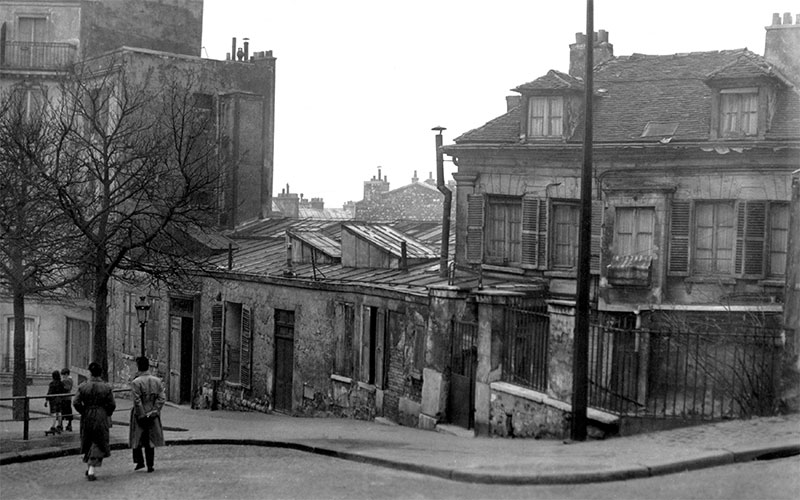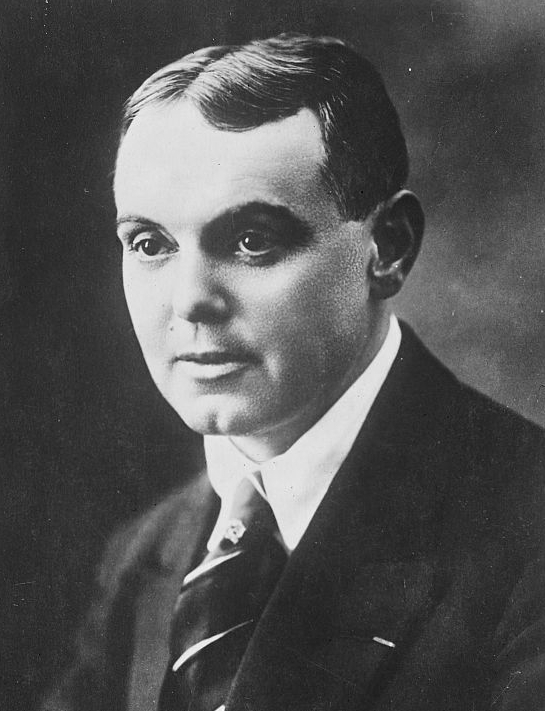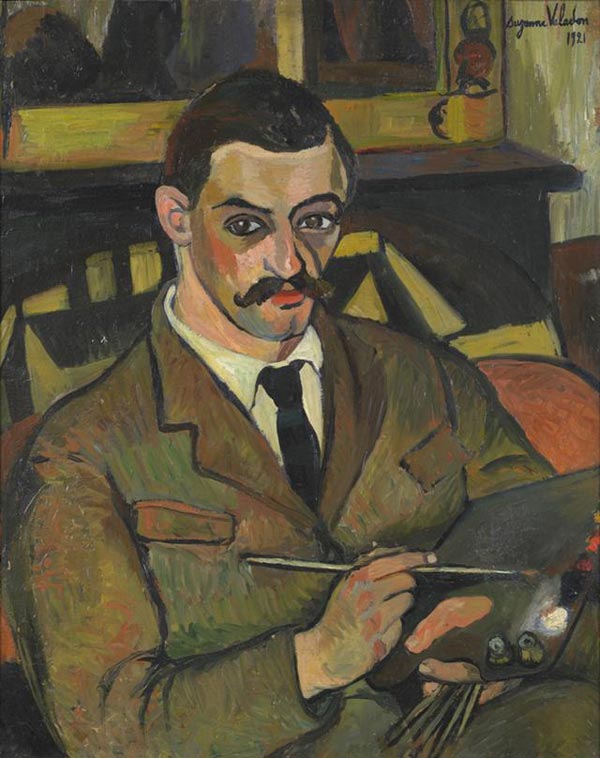|
Le Bateau-Lavoir
The Bateau-Lavoir ("Washhouse Boat") is the nickname of a building in the Montmartre district of the 18th arrondissement of Paris that is famous in art history as the residence and meeting place for a group of outstanding early 20th-century artists, men of letters, theatre people, and art dealers. It is located at No. 13 Rue Ravignan at Place Emile Goudeau, just below the Place du Tertre. A fire destroyed most of the building in May 1970 and only the façade remained, but it was completely rebuilt in 1978. History Formerly a ballroom and piano factory, Bateau Lavoir was squatted and divided into 20 small workshops in 1889. Distributed along a corridor, small rooms were linked without heating and with a single point of water. The name "Le Bateau-Lavoir" was coined by French poet Max Jacob. The building was dark and dirty, almost seeming to be scrap pile rather than a dwelling. On stormy days, it swayed and creaked, reminding people of washing-boats on the Seine River, hence the na ... [...More Info...] [...Related Items...] OR: [Wikipedia] [Google] [Baidu] |
Pierre Mac Orlan
Pierre Mac Orlan, sometimes written MacOrlan (born Pierre Dumarchey, February 26, 1882 – June 27, 1970), was a French novelist and songwriter. His novel '' Quai des Brumes'' was the source for Marcel Carné's 1938 film of the same name, starring Jean Gabin. He was also a prolific writer of ''chansons'', many of which were recorded and popularized by French singers such as Juliette Gréco, Monique Morelli, Catherine Sauvage, and Germaine Montero. Life Born in Péronne, Somme, in northern France, Mac Orlan lived in Rouen and Paris as a young man, working at a variety of jobs and learning to play the accordion. In his twenties, he travelled widely in Europe, before returning to Paris and becoming a noted figure in bohemian art circles. In particular, his song performances were a regular feature at the Lapin Agile cabaret. During this period, he was part of a broad circle of writers and painters including Max Jacob, Guillaume Apollinaire, Maurice Utrillo and Francis Carco. He fo ... [...More Info...] [...Related Items...] OR: [Wikipedia] [Google] [Baidu] |
María Blanchard
María Blanchard (born María Gutiérrez-Cueto y Blanchard; spanish-art.org; accessed 4 August 2015. 6 March 1881 – 5 April 1932) was a Spanish painter. She was known for developing a unique style of . Biography Blanchard was born on 6 March 1881 in . She was the daughter of journalist Enrique Gutiérrez Cueto and Concepción Blanchard Santisteban. She was the cousin of Mexican artist |
Jacques Lipchitz
Jacques Lipchitz (26 May 1973) was a Cubist sculptor. Lipchitz retained highly figurative and legible components in his work leading up to 1915–16, after which naturalist and descriptive elements were muted, dominated by a synthetic style of Crystal Cubism. In 1920 Lipchitz held his first solo exhibition, at Léonce Rosenberg's Galerie L'Effort Moderne in Paris. Fleeing the Nazis he moved to the US and settled in New York City and eventually Hastings-on-Hudson. Life and career Jacques Lipchitz was born Chaim Jacob Lipschitz, in a Litvak family, son of a building contractor in Druskininkai, Lithuania, then within the Russian Empire. He studied at Vilnius grammar school and Vilnius Art School. Under the influence of his father he studied engineering in 1906–1909, but soon after, supported by his mother he moved to Paris (1909) to study at the École des Beaux-Arts and the Académie Julian. It was there, in the artistic communities of Montmartre and Montparnasse, that he jo ... [...More Info...] [...Related Items...] OR: [Wikipedia] [Google] [Baidu] |
Maurice Utrillo
Maurice Utrillo (), born Maurice Valadon; 26 December 1883 – 5 November 1955), was a French painter of the School of Paris who specialized in cityscapes. Born in the Montmartre quarter of Paris, France, Utrillo is one of the few famous painters of Montmartre who were born there. Biography Utrillo was the son of the artist Suzanne Valadon (born Marie-Clémentine Valadon), who was then an eighteen-year-old artist's model. She never revealed who was the father of her child; speculation exists that he was the offspring from a liaison with an equally young amateur painter named Boissy, or with the well-established painter Pierre-Cécile Puvis de Chavannes, or even with Renoir. (see below under ''Paternity''). In 1891 a Spanish artist, Miquel Utrillo, signed a legal document acknowledging paternity, although the question remains as to whether he was in fact the child's father. Valadon, who became a model after a fall from a trapeze ended her chosen career as a circus acrobat, fou ... [...More Info...] [...Related Items...] OR: [Wikipedia] [Google] [Baidu] |
Jean-Paul Laurens
Jean-Paul Laurens (; 28 March 1838 – 23 March 1921) was a French painter and sculptor, and one of the last major exponents of the French Academic style. Biography Laurens was born in Fourquevaux and was a pupil of Léon Cogniet and Alexandre Bida. Strongly anti-clerical and republican, his work was often on historical and religious themes, through which he sought to convey a message of opposition to monarchical and clerical oppression. His erudition and technical mastery were much admired in his time, but in later years his highly realistic technique, coupled to a theatrical ''mise-en-scène'', came to be regarded by some art-historians as overly didactic. More recently, however, his work has been re-evaluated as an important and original renewal of history painting, a genre of painting that was in decline during Laurens' lifetime. Laurens was commissioned to paint numerous public works by the French Third Republic, including the steel vault of the Paris City Hall, the monu ... [...More Info...] [...Related Items...] OR: [Wikipedia] [Google] [Baidu] |
Marie Laurencin
Marie Laurencin (31 October 1883 – 8 June 1956) was a French painter and printmaker. She became an important figure in the Parisian Avant-garde#:~:text=The avant-garde (/ˌ,art, culture, or society., avant-garde as a member of the Cubism, Cubists associated with the Section d'Or. Biography Laurencin was born in Paris, where she was raised by her mother and lived much of her life. At 18, she studied porcelain painting in Sèvres. She then returned to Paris and continued her art education at the Académie Humbert, where she changed her focus to oil painting. During the early years of the 20th century, Laurencin was an important figure in the Parisian avant-garde. A member of both the circle of Pablo Picasso, and Cubists associated with the Section d'Or, such as Jean Metzinger, Albert Gleizes, Robert Delaunay, Henri le Fauconnier and Francis Picabia, exhibiting with them at the Salon des Indépendants (1910-1911) and the Salon d'Automne (1911-1912), and Galeries Dalmau (1912) at th ... [...More Info...] [...Related Items...] OR: [Wikipedia] [Google] [Baidu] |
Raoul Dufy
Raoul Dufy (; 3 June 1877 – 23 March 1953) was a French Fauvism, Fauvist painter. He developed a colorful, decorative style that became fashionable for designs of ceramic art, ceramics and textile as well as decorative schemes for public buildings. He is noted for scenes of open-air social events.He was also a drawing, draftsman, printmaker, book illustrator, scenic designer, a designer of furniture and a planner of public spaces. Biography Early life Dufy was born into a large family at Le Havre, in Normandy. He had a younger brother, Jean Dufy, who also became an artist. Dufy left school at the age of fourteen to work in a coffee-importing company. In 1895, when he was 18, he started taking evening classes in art at Le Havre's École des Beaux-Arts (municipal art school). The classes were taught by Charles Lhuillier, who forty years earlier had been a student of the French portrait painter Ingres. There Dufy met and Othon Friesz, with whom he later shared a studio in Mo ... [...More Info...] [...Related Items...] OR: [Wikipedia] [Google] [Baidu] |
André Derain
André Derain (, ; 10 June 1880 – 8 September 1954) was a French artist, painter, sculptor and co-founder of Fauvism with Henri Matisse. Biography Early years Derain was born in 1880 in Chatou, Yvelines, Île-de-France, just outside Paris. In 1895 he began to study on his own, contrary to claims that meeting Vlaminck or Matisse began his efforts to paint, and occasionally went to the countryside with an old friend of Cézanne's, Father Jacomin along with his two sons. In 1898, while studying to be an engineer at the Académie Camillo, he attended painting classes under Eugène Carrière, and there met Matisse. In 1900, he met and shared a studio with Maurice de Vlaminck and together they began to paint scenes in the neighbourhood, but this was interrupted by military service at Commercy from September 1901 to 1904. Following his release from service, Matisse persuaded Derain's parents to allow him to abandon his engineering career and devote himself solely to painting; subs ... [...More Info...] [...Related Items...] OR: [Wikipedia] [Google] [Baidu] |





